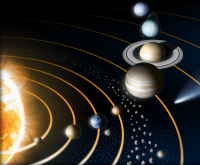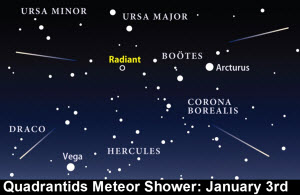- Planetary Skylights: Jupiter, Mars, Saturn and Mercury all visible this month, as well as two asteroids (Ceres and Vesta)
- Meteor Watch: Capri-Cornids, Alpha-Cygnids and Delta-Aquarids visible this month
- July 2014 Sky Charts: a view of the constellations in July's night sky
- Log in to post comments


 With a New moon on the 1st, you may spot a few shooting stars early in the New Year; especially on the evening of the 3rd, when the Quadrantids meteor shower peaks.
With a New moon on the 1st, you may spot a few shooting stars early in the New Year; especially on the evening of the 3rd, when the Quadrantids meteor shower peaks. 